完整版)营养与食品卫生学重点
营养及食品卫生全本重点汇总

GB2760-2014规定,在哪些情况下可使用食品添加剂:1不对人体产生任何健康危害2不应掩盖食品腐败变质3不掩盖食品本身和加工过程的质量缺陷或以掺杂,造假为目的使用的添加剂4不降低食品本身的营养价值5在达到预期效果的前提下尽可能降低使用量。
营养与食品卫生学:研究饮食与健康的相互作用及其规律,作用机制及据此提出预防疾病,保护和促进健康措施政策和法规等。
营养素:为维持机体繁殖,生长发育和生存等一切生命活动和过程,需要从外界环境中摄取的物质。
特点:1必须从外界获取2能够满足机体的最低需求,分蛋白质,脂类,碳水化合物,矿物质和维生素。
分为宏量和微量营养素膳食营养素参考摄入量(DRIS):在推荐的每日膳食营养摄入量基础发展起来的一组每日膳食营养素摄入的参考值。
包括:平均需要量,推荐摄入量,适宜摄入量,可耐受最高摄入量必需氨基酸essential amino acid e:人体内不能合成或合成速度不能满足机体需要,必需从食物中直接获得的氨基酸,包括:撷氨酸、异亮氨酸、亮氨酸、苯丙氨酸、蛋氨酸、色氨酸、苏氨酸、赖氨酸、组氨酸。
功能:①合成组织蛋白质;②转变为酶、激素、抗体、肌酸等含氮物质;③转变为碳水化合物和脂肪;④氧化成二氧化碳和水及尿素,产生能量。
条件必需氨基酸:可减少人体对某些必需氨基酸需要量的氨基酸。
氨基酸模式amino acid pattern:蛋白质中各种必需氨基酸的构成比例。
限制氨基酸l imiting amino acid:含量相对较低的必需氨基酸。
优质蛋白质:含必需氨基酸种类齐全,氨基酸模式与人体蛋白质氨基酸模式接近,营养价值较高,不仅可维持成人的健康,也可促进儿童生长、发育的蛋白质。
半完全蛋白:大多数植物蛋白虽含有种类齐全的必需氨基酸,但氨基酸模式与人体蛋白质模式差异很大,其中一种或几种必需氨基酸含量较低,使得蛋白质营养价值降低,虽可维持生命但不能促进生长发育。
蛋白质互补作用:不同食物间相互补充其必需氨基酸不足的作用。
《营养与食品卫生学》重点知识整理
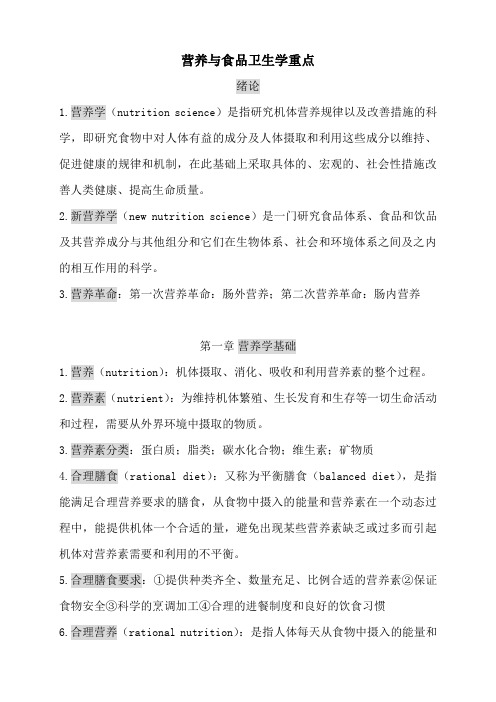
营养与食品卫生学重点绪论1.营养学(nutrition science)是指研究机体营养规律以及改善措施的科学,即研究食物中对人体有益的成分及人体摄取和利用这些成分以维持、促进健康的规律和机制,在此基础上采取具体的、宏观的、社会性措施改善人类健康、提高生命质量。
2.新营养学(new nutrition science)是一门研究食品体系、食品和饮品及其营养成分与其他组分和它们在生物体系、社会和环境体系之间及之内的相互作用的科学。
3.营养革命:第一次营养革命:肠外营养;第二次营养革命:肠内营养第一章营养学基础1.营养(nutrition):机体摄取、消化、吸收和利用营养素的整个过程。
2.营养素(nutrient):为维持机体繁殖、生长发育和生存等一切生命活动和过程,需要从外界环境中摄取的物质。
3.营养素分类:蛋白质;脂类;碳水化合物;维生素;矿物质4.合理膳食(rational diet):又称为平衡膳食(balanced diet),是指能满足合理营养要求的膳食,从食物中摄入的能量和营养素在一个动态过程中,能提供机体一个合适的量,避免出现某些营养素缺乏或过多而引起机体对营养素需要和利用的不平衡。
5.合理膳食要求:①提供种类齐全、数量充足、比例合适的营养素②保证食物安全③科学的烹调加工④合理的进餐制度和良好的饮食习惯6.合理营养(rational nutrition):是指人体每天从食物中摄入的能量和各种营养素的量及其相互间的比例能满足在不同生理阶段、不同劳动环境及不同劳动强度下的需要,并使机体处于良好的健康状态。
7.膳食营养素参考摄入量(dietary reference intakes, DRIs)包括:平均需要量(EAR);推荐摄入量(RNI);适宜摄入量(AI);可耐受最高摄入量(UL)8.推荐摄入量( recommended nutrient intake,RNI):是指可以满足某一特定性别、年龄及生理状况群体中绝大多数个体(97%~98%)需要量的某种营养素的摄入水平。
营养与食品安全卫生学 考试重点总结

绪论名词解释:营养:是指人体摄取食物,经过体内的消化、吸收和代谢,利用食物中的有益物质以满足机体自身生理需要的生物学过程。
第一章营养学基础第一节蛋白质:1、①分类:根据组成成分分类:单纯蛋白质、结合蛋白质;根据营养价值分类:完全蛋白质、半完全蛋白质、不完全蛋白质;②氨基酸:必需氨基酸(重点):赖氨酸、亮氨酸、异亮氨酸、蛋氨酸、苯丙氨酸、苏氨酸、色氨酸、结氨酸及组氨酸(婴儿必需);条件必需氨基酸(重点):半胱氨酸(由蛋氨酸合成)、酪氨酸(苯丙氨酸合成);③氨基酸模式:是指蛋白质中各种必需氨基酸的构成比例;2、名词解释:生物价(BV):蛋白质生物价是反映被消化吸收后的待测蛋白质被机体利用的程度。
3、食物来源:①动物性食品;②大豆类食品;第二节脂类1、脂类的分类:⑴三酰甘油;⑵类脂:①磷脂;②糖脂;③固醇类:胆固醇、植物固醇;2、脂肪酸的分类:⑴按脂肪酸的碳链长度分类:①长链脂肪酸(含14个碳以上);②中链脂肪酸(8~12个碳);③短链脂肪酸;⑵按脂肪酸的饱和程度分类:①饱和脂肪酸;②单不饱和脂肪酸;③多不饱和脂肪酸;⑶按脂肪酸的空间结构:①顺式脂肪酸;②反式脂肪酸;⑷按不饱和脂肪酸的双键位置分类:①n-3系列不饱和脂肪酸;②n-6系列不饱和脂肪酸;⑸按双键的几何型态分类:①共轭脂肪酸;②非共轭脂肪酸;3、名词解释:⑴必需脂肪酸(EFA);是指人体不能缺少而自身又不能合成,必需通过食物供给的脂肪酸;⑵包括①n-3系列不饱和脂肪酸;②n-6系列不饱和脂肪酸;4、当C20:3/C20:4的比值大于0.4时,认为是必需脂肪酸缺乏;5、脂类的生理功能:⑴提供能量和储存能量;⑵提供必需脂肪酸;⑶促进脂溶性维生素的吸收;⑷是人体的重要组成成分,维持细胞结构和功能;⑸对人体有保护作用,能保护内脏器官;⑹维持体温正常;6、膳食脂类营养价值的评价:⑴必需脂肪酸及n-3系列脂肪酸的含量:必需脂肪酸含量越高,脂类的营养价值就越高;⑵脂溶性维生素的含量:脂溶性维生素含量高的脂类营养价值也高;⑶脂类的稳定性;⑷脂肪的消化率;7、亚油酸的转化:亚油酸→二十碳三烯酸→花生四烯酸;8、脂类的食物来源:⑴动物性脂肪:畜禽肉、猪油等;⑵植物性脂肪:菜油、大豆油、花生油等;第三节碳水化合物1、乳糖不耐受症(factose intolerance)(原发性分解乳糖的酶缺乏):有些人由于小肠粘膜上皮细胞刷状缘上的乳糖酶分泌减少或缺乏,会导致乳糖消化和吸收障碍,在摄入含有乳糖的奶类及其制品以后,会出现胃肠不适。
(完整版)营养与食品卫生学重点

(完整版)营养与食品卫生学重点-CAL-FENGHAI-(2020YEAR-YICAI)_JINGBIAN绪论营养学:是研究人体营养规律及其改善措施的科学。
营养:是指人体摄取、消化、吸收和利用食物中营养物质以满足机体生理需要的生物学过程。
《皇帝内经素问》:“五谷为养,五果为助,五畜为益,五菜为充,气味合而服之,以补精益气”。
现代营养学分为三个时期:(始于18世纪中叶)。
1.营养学的萌芽与形成期(1785--1945年):1983:提出“蛋白质”;亮氨酸/苏氨酸;1920:“维生素”。
2.营养学的全面发展与成熟期(1945--1985年):公共营养兴起。
3.营养学发展的突破与孕育期(1985年--):植物化学物、分子营养学、新营养学。
第一章营养学基础营养素(nutrient):是指食物中可给人体提供能量、机体构成成分和组织修复以及生理调节功能的化学成分。
营养素六大类:水、脂肪、糖类、蛋白质、矿物质、维生素。
C、H、O、N占人体96%以上;细胞内液ICF(2/3)、外液ECF(1/3);骨密度(BMD);血液5L。
蛋白质(protein)必需氨基酸:指人体不能合成或合成速度不能满足机体需要,必须从食物中直接获得的氨基酸。
8+1:蛋氨酸、赖氨酸、缬氨酸、异亮氨酸、苯丙氨酸、亮氨酸、色氨酸、苏氨酸;组氨酸(婴儿)。
条件必需氨基酸:半胱氨酸←←蛋氨酸、酪氨酸←←苯丙氨酸。
氨基酸模式:蛋白质中各种必需氨基酸的构成比例。
(色氨酸为1)。
完全蛋白质:种类齐全,模式接近,可维持成人健康,也可促进儿童生长发育。
参考蛋白—鸡蛋蛋白质。
限制氨基酸:食物蛋白质中一种或几种必需氨基酸相对含量较低,导致其它氨基酸在体内不能被充分利用而浪费造成其营养价值降低,这些相对含量较低的氨基酸称为限制氨基酸。
蛋白质互补作用:不同食物间相互补充必需氨基酸不足的作用。
蛋白质的功能:1.构成机体组织;2.构成特殊生理活性物质;3.供能:1g食物蛋白质在体内产生16.7kJ能量。
(完整版)营养与食品卫生学复习重点

第一章绪论1、营养:食物在体内经过消化、吸收和代谢以满足机体生长发育、生理功能、组织更新、体力活动需要的生物学过程。
2、营养素:为维持机体繁殖、生长发育和生存等一切生命活动和过程,需要从外界环境中摄取的物质。
包括宏量:蛋白质、脂类、碳水化合物;微量:维生素、矿物质;水。
3、水:不仅构成身体成分,还具备调节生理功能的作用。
水的生理功能:构成细胞和体液的重要组成部分;参与新陈代谢;调节体温;润滑作用. 健康成人每天需要水2500ml左右。
在温和气候条件生活的轻体力活动的成年人,每日至少饮水1200ml(约6杯)。
4、植物化学物:指植物性食品中除含人体必需营养成分外的一些低分子量生物活性物质,是植物的次级代谢产物.主要包括:类胡萝卜素、植物固醇、皂苷、芥子油苷、多酚、蛋白酶抑制剂、单萜类、植物雌激素、硫化物、植酸等几大类。
5、合理膳食:又称为平衡膳食,是指提供给机体种类齐全、数量充足、比例合适的能量和各种营养素,并与机体的需要保持平衡,进而达到合理营养、促进健康、预防疾病的膳食。
合理膳食要求:提供种类齐全、数量充足、比例合适的营养素;保证食物安全;科学的烹调加工;合理的进餐制度和良好的饮食习惯.6、营养素的代谢:指生物体与外界环境之间物质的交换和生物体内物质的转变过程。
包括:消化吸收;中间代谢;排泄。
营养素的生理功能: 提供能量;构成细胞组织,供给生长、发育和自我更新所需的材料;调节机体生理活动。
合理营养:即为平衡而全面的营养。
包括两方面内容:一方面为满足机体对各种营养素及能量的需要;另一方面为各营养素之间比例要适宜。
营养失衡造成的危害:营养不良,是指由于一种或一种以上营养素的缺乏或过剩所造成的机体健康异常或疾病状态。
包括两种表现,即营养缺乏和营养过剩.膳食营养素参考摄入量(DRIs):是在RDA基础上发展起来的一组每日平均膳食营养素摄入量的参考值,包括4项内容:平均需要量(EAR);推荐摄入量(RNI);适宜摄入量(AI);可耐受最高摄入量(UL)11、平均需要量(EAR)是某一特定性别、年龄及生理状况群体中对某营养素需要量的平均值。
《营养与食品卫生学》重点名词解释完整

1.营养:是指机体从外界摄取事物,经过体内的消化、吸收和或代谢后,或参与构建组织器官,或满足生理功能和体力活动需要的必要的生物学过程。
2.营养学:是指研究营养规律以及改善措施的科学,即研究食物中对人体摄取和利用这些成分以维持、促进、健康的规律及机制,在此基础上采取具体的宏观的、社会性措施改善人类健康、提高生命质量。
3.食品卫生学:是指研究食品中可能存在的危害人体健康有害因素及其对集体的作用规律和机制,在此基础上提出具体、宏观的预防措施,以提高食品卫生质量,保护食品使用者安全的科学。
4.营养素:指食物中可给人体提供能量,机体构成成分和组织修复以及生理调节功能的化学成分。
5.氮平衡:摄入氮的量与排除氮的量之间的关系,摄入氮和排出氮相等是为零氮平衡、摄入氮多于排出氮则为正氮平衡,反之则为负氮平衡。
6.必需氨基酸:人体不能自身合成或者合成速度不能满足人体需要,必须要从食物中直接供给的氨基酸。
7.氨基酸模式:某种蛋白质中各种必需氨基酸之间的比例。
其计算方法时将蛋白质中的色氨酸含量定为1,分别计算其他必需氨基酸的相应比值,这一系列的比值是该种蛋白质的氨基酸模式化。
8.参考蛋白质:可以用来评价其他蛋白质质量的标准蛋白,例如鸡蛋蛋白。
9.蛋白质功效比值(PER):处于生长发育阶段的幼年动物,在试验期间内,摄入蛋白质的量与其体重增加量之间的比例。
10.限制性氨基酸:在蛋白质中,含量较低的必须氨基酸可以干扰其他必需氨基酸的利用和吸收,从而降低了蛋白质中其他必需氨基酸的利用价值,其中含量最低的必需氨基酸称为第一限制氨基酸。
以此类推。
11.氨基酸评分:某种食物蛋白质中1g氮的必需氨基酸含量与标准蛋白质中1g氮的必需氨基酸含量之间的比值,用于反映蛋白质中的构成和利用关系。
12.必需脂肪酸(EFA):人体不能自身合成,必须通过食物摄取的那部分脂肪酸。
13.食物热效应:人体在摄食过程中,由于摄食而引起的额外能量消耗,其中蛋白质的食物热效应最高。
营养与食品卫生学重点笔记

营养与食品卫生学(营养学基础)1.人体必需氨基酸: 缬亮异亮苏氨酸, 赖色苯丙甲硫氨(蛋), 组(儿童)。
借一两本淡色书来2.蛋白质的互补作用实质上是使:几种必需氨基酸在比例上接近人体的需要, 比原有的任何一种蛋白质的生物学价值都高。
3、必需氨基酸:人体不能合成或合成速度比较慢, 不能满足机体需要, 必须由食物供应的。
4、蛋白质生物学价值是表达: 蛋白质被吸取后在体内被运用的限度。
蛋白质生物学价值=氮储留量/ 氮吸取量×1005.食物特殊动力作用是指: 机体由于摄食过程引起体内能量消耗增长的作用。
食物特殊动力作用最大的是: 蛋白质。
色氨酸60→尼克酸(烟酸)17、膳食中胱氨酸与酪氨酸富余时, 可以节约蛋氨酸30%和苯丙氨酸50%, 前两者是条件必须氨基酸。
8、氮平衡: 摄入氮=排出氮(正常成年人)正氮平衡: 摄入氮>排出氮(儿童、青少年、孕妇、恢复期病人)负氮平衡: 摄入氮<排出氮(蛋白质摄入局限性、消耗性疾病、吸取不良)排出氮=尿氮+粪氮+通过汗液排出的氮9、受机体营养状态和活动量影响而变动的动脂, 是指: 甘油三酯。
类脂质(磷脂、糖脂、脂蛋白、胆固醇)被称为: 定脂。
10、对老年人和动脉硬化患者每人每日胆固醇摄入量应: 不超过300mg。
11.单糖类: 葡萄糖、果糖、半乳糖。
双糖类: 蔗糖(葡萄糖+果糖)、麦芽糖(两分子葡萄糖)、乳糖(葡萄糖+半乳糖)。
多糖类: 淀粉、糊精、糖原(又称动物淀粉)、纤维素、半纤维素、果胶。
12.目前认为必须脂肪酸有两种: 亚油酸、α-亚麻酸。
13.必须脂肪酸的生理功能: 参与脂质代谢;是组织细胞的组成成分;是合成前列腺素的前体物;有减少血栓形成和血小板粘结作用。
(与参与血红蛋白的合成无关)14、必须脂肪酸最佳的食物来源是植物油类, 特别是: 棉油、大豆油、玉米油。
15.过量摄入能在体内贮存并可引起中毒的是: 维生素A。
16、当碳水化合物摄入局限性时, 脂肪供热因氧化不全而产生过量的:酮体。
《营养与食品卫生》重点总结(考试复习必备)
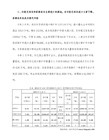
绪论名词解释:营养:是指人体摄取食物,经过体内的消化、吸收和代谢,利用食物中的有益物质以满足机体自身生理需要的生物学过程。
第一章营养学基础加油!加油!第一节蛋白质:蛋白质:是机体细胞、组织和器官的重要组成结构,是功能因子和调控因子的重要组成成分,是一切生命的物质基础。
基本构成单位是氨基酸,由肽键(酰胺键)连接。
(一)氨基酸(构成人体蛋白质的氨基酸20种,不包括胱氨酸,1. 必需氨基酸(essential amino acid):必需氨基酸是指人体内不能合成或合成速度不能满足机体需要,必须从食物中直接获得的氨基酸(8+1:蛋-缬-赖-异-苯-亮-色-苏,组氨酸(婴儿)2. 条件必需氨基酸(conditionally essential amino acid)半胱氨酸和酪氨酸这类可减少人体对某些必需氨基酸需要量的氨基酸。
(2种:蛋氨酸-半胱氨酸;苯丙氨酸-酪氨酸)3. 非必需氨基酸(nonessential amino acid)非必需氨基酸是指人体可以自身合成,不一定需要从食物中直接供给的氨基酸。
(9种)(二)氨基酸模式和限制氨基酸:1氨基酸模式(amino acid pattern):蛋白质中各种必需氨基酸的构成比例。
(色氨酸含量定1)2限制氨基酸(limiting amino acid):含量相对较低的必需氨基酸,影响其它氨基酸的利用,其中含量最低的称为第一限制氨基酸。
3蛋白质分类:(1)完全蛋白质(优质蛋白):这类含必须氨基酸种类齐全,氨基酸模式与人体蛋白质氨基酸模式接近,营养价值较高,不仅可以维持成人健康,也可促进儿童生长发育的蛋白质。
(蛋、奶、鱼等动物蛋白,大豆蛋白;鸡蛋-参考蛋白)(2)半完全蛋白质:蛋白质中虽然含有种类齐全的必须氨基酸,但是氨基酸模式与人体蛋白质氨基酸模式差异较大,其中一种或几种必须氨基酸相对含量较低,导致其它的必须氨基酸在体内不能充分利用而浪费,造成蛋白质营养价值较低,虽可维持生命但不能促进生长发育。
《公共营养师考试营养与食品卫生学重点》

一、绪论1. 营养学研究内容:食物营养、人体营养、公共营养。
2. 食品卫生学研究内容:食品的污染、食品及其加工技术的卫生问题、食源性疾病及食品安全评价体系的建立、食品卫生监督管理。
3. 营养学的研究方法:营养流行病学方法、营养代谢研究方法、营养状况评价方法。
二、营养学基础1. 蛋白质(1)生理功能:人体组织的构成成分;构成体内各种重要的生理活性物质;供给能量(1g蛋白质16.7kJ能量)。
(2)必需氨基酸:蛋氨酸、缬氨酸、赖氨酸、异亮氨酸、苯丙氨酸、亮氨酸、色氨酸、苏氨酸、组氨酸(婴儿)。
(3)条件必需氨基酸:半胱氨酸、蛋氨酸,酪氨酸、苯丙氨酸。
(4)氨基酸模式:蛋白质中各种必需氨基酸的构成比例。
(5)限制氨基酸:大多数植物蛋白质都是半完全蛋白,这些含量相对较低的必需氨基酸称为限制氨基酸,其中,含量最低的称为第一限制氨基酸。
(6)蛋白质的功能:人体组织的构成成分;构成体内各种重要的生理活性物质;供给能量。
(7)氮平衡:摄入氮-(尿氮、粪氮、皮肤等氮损失)BI-(UFS)。
(8)蛋白质真消化率(%)【食物氮-(粪氮-粪代谢氮)】/食物氮x100%。
2. 脂类(1)脂类营养学意义。
(2)必需脂肪酸的定义及功能。
(3)参考摄入量及食物来源。
3. 碳水化合物(1)碳水化合物分类及营养学意义。
(2)碳水化合物参考摄入量及食物来源。
(3)膳食纤维的生理功能。
4. 能量(1)能量单位和能量系数。
(2)人体一日能量需要量的确定。
(3)生热营养素的供能比例。
5. 矿物质(1)矿物质的概念及生理特点。
(2)钙、铁、碘、锌、硒的生理功能及缺乏。
(3)钙、铁、碘、锌参考摄入量及食物来源。
6. 维生素(1)维生素的特点及分类。
(2)维生素A、维生素D、维生素E、维生素B1、维生素B2、维生素C、烟酸及叶酸的生理功能及缺乏症、参考摄入量及食物来源。
三、各类食品的营养价值1. 植物性食品(1)谷类食品:大米、小麦、玉米等。
(2)蔬菜:绿叶蔬菜、根茎类蔬菜、瓜类蔬菜等。
(完整版)营养与食品卫生学重点笔记(最新整理)
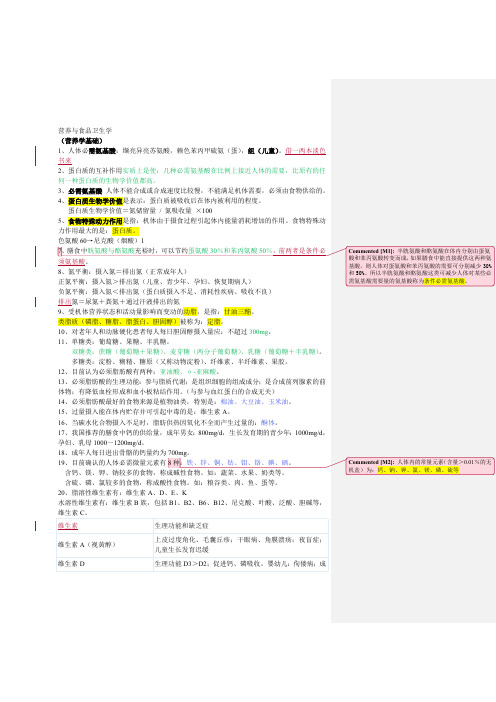
2、乳母和怀孕末期妇女每日钙的供给量应为:1200mg。
3、怀孕末期,每日应额外增加:热能200kcal、蛋白质20g。
4、孕妇每日铁的供给量应为:25mg。
5、怀孕初期为减少恶心、食欲不振现象,应增加:维生素B6。
6、老年人基础代谢逐渐降低,一般比青壮年低10%~15%。
7、老年人蛋白质的供给,每日每公斤体重应供给:1.27g。
8、WHO号召80%的婴儿应在出生后4个月内得到母乳喂养。
9、乳汁中含量较恒定的矿物质是:钙;初乳中含量较丰富的维生素是:维生素A。
(营养调查)1、牙龈经常出血是缺乏维生素C的表现之一。
2、动物和豆类蛋白占膳食蛋白质的30%以上时,可认为膳食蛋白质的质量较好。
3、毛囊角化症是缺乏维生素A的表现之一。
4、多发性神经炎是缺乏维生素B1的表现之一。
;5、膳食调查中,“24小时膳食回顾法”最容易取得可靠的营养素摄入资料。
一般认为,其它营养素的摄入量占推荐量的80%以上为正常。
7、一般认为,能量摄入量为推荐摄入量的90%~110%为正常。
(食品卫生学总论)1、评价食品卫生质量的细菌污染指标包括两个方面:一是菌落总数(一般卫生学标准),二是大肠菌群(食品的粪便污染指标)。
2、菌落总数-1g或1ml或1cm2食品在严格规定的条件下经培养生成的细菌菌落总数。
3、我国和其他许多国家均采用当于100g或100ml食品中大肠菌群最近似值(MPN)表示食品中大肠菌群的数量。
4、凡以食品作为来源或媒介而传播的疾病,总称为:食源性疾病。
5、食品腐败变质是指:在各种因素作用下,食品降低或失去了食用价值。
6、N-亚硝基化合物可由亚硝酸盐和胺类等化合物合成,体内合成N-亚硝基化合物的主要场所为:胃。
7、黄曲霉毒素除由黄曲霉产生外,还可由寄生曲霉(另一种真菌)产生。
8、低温长时间巴氏消毒法:62~65℃,30min;高温瞬间巴氏消毒法:80~90℃,1min或30’超高温灭菌法:120~130℃,2~3’(低温长时间巴氏消毒法:最初10min杀灭大部分繁殖型微生物;第二个10min可使个别耐热性微生物死亡;最后10min是为了保证安全。
营养学与食品卫生学重点
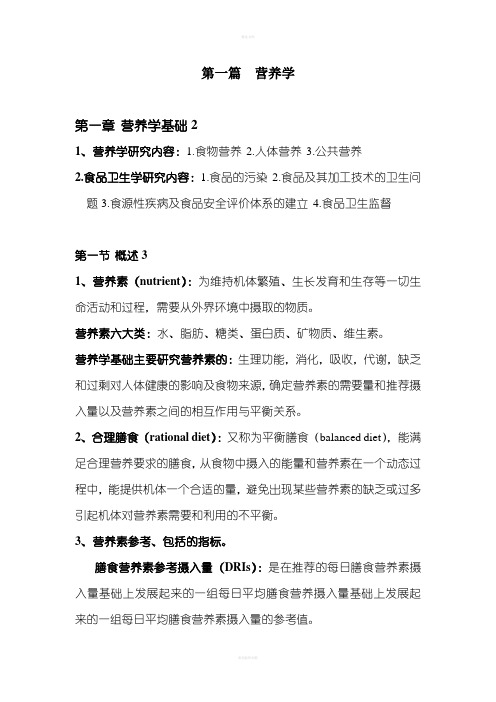
第一篇营养学第一章营养学基础21、营养学研究内容:1.食物营养2.人体营养3.公共营养2.食品卫生学研究内容:1.食品的污染2.食品及其加工技术的卫生问题3.食源性疾病及食品安全评价体系的建立4.食品卫生监督第一节概述31、营养素(nutrient):为维持机体繁殖、生长发育和生存等一切生命活动和过程,需要从外界环境中摄取的物质。
营养素六大类:水、脂肪、糖类、蛋白质、矿物质、维生素。
营养学基础主要研究营养素的:生理功能,消化,吸收,代谢,缺乏和过剩对人体健康的影响及食物来源,确定营养素的需要量和推荐摄入量以及营养素之间的相互作用与平衡关系。
2、合理膳食(rational diet):又称为平衡膳食(balanced diet),能满足合理营养要求的膳食,从食物中摄入的能量和营养素在一个动态过程中,能提供机体一个合适的量,避免出现某些营养素的缺乏或过多引起机体对营养素需要和利用的不平衡。
3、营养素参考、包括的指标。
膳食营养素参考摄入量(DRIs):是在推荐的每日膳食营养素摄入量基础上发展起来的一组每日平均膳食营养摄入量基础上发展起来的一组每日平均膳食营养素摄入量的参考值。
膳食营养素参考摄入量(DRIs)包括四个营养水平指标:平均需要量、推荐摄入量、适宜摄入量和可耐受最高摄入量。
第四节蛋白质51、必需氨基酸概念、怎样相互转化?必需氨基酸(essential amino acid):人体内不能合成或合成速度不能满足机体需要,必须从食物中直接得到的氨基酸。
分为:缬氨酸、异亮氨酸、亮氨酸、苯丙氨酸、蛋氨酸、色氨酸、苏氨酸、赖氨酸和组氨酸(婴儿)。
条件必需氨基酸转化:半胱氨酸←蛋氨酸、酪氨酸←←苯丙氨酸。
2、蛋白质分类、互补作用、怎样最大效益利用蛋白质?蛋白质分类:完全蛋白质(优质蛋白质)、半完全蛋白质、不完全蛋白质。
蛋白质互补作用:不同食物间相互补充必需氨基酸不足的作用。
为了提高食物蛋白质的营养价值,人们往往将不同的食物混合食用,使各种食物所含的必需氨基酸互相补偿,可使混合膳食蛋白质的氨基酸模式接近于人体要求的氨基酸模式,以提高蛋白质的营养价值,这种现象称为互补作用。
《营养与食品卫生学》重点知识整理

营养与食品卫生学重点绪论1.营养学(nutrition science)是指研究机体营养规律以及改善措施的科学,即研究食物中对人体有益的成分及人体摄取和利用这些成分以维持、促进健康的规律和机制,在此基础上采取具体的、宏观的、社会性措施改善人类健康、提高生命质量。
2.新营养学(new nutrition science)是一门研究食品体系、食品和饮品及其营养成分与其他组分和它们在生物体系、社会和环境体系之间及之内的相互作用的科学。
3.营养革命:第一次营养革命:肠外营养;第二次营养革命:肠内营养第一章营养学基础1.营养(nutrition):机体摄取、消化、吸收和利用营养素的整个过程。
2.营养素(nutrient):为维持机体繁殖、生长发育和生存等一切生命活动和过程,需要从外界环境中摄取的物质。
3.营养素分类:蛋白质;脂类;碳水化合物;维生素;矿物质4.合理膳食(rational diet):又称为平衡膳食(balanced diet),是指能满足合理营养要求的膳食,从食物中摄入的能量和营养素在一个动态过程中,能提供机体一个合适的量,避免出现某些营养素缺乏或过多而引起机体对营养素需要和利用的不平衡。
5.合理膳食要求:①提供种类齐全、数量充足、比例合适的营养素②保证食物安全③科学的烹调加工④合理的进餐制度和良好的饮食习惯6.合理营养(rational nutrition):是指人体每天从食物中摄入的能量和各种营养素的量及其相互间的比例能满足在不同生理阶段、不同劳动环境及不同劳动强度下的需要,并使机体处于良好的健康状态。
7.膳食营养素参考摄入量(dietary reference intakes, DRIs)包括:平均需要量(EAR);推荐摄入量(RNI);适宜摄入量(AI);可耐受最高摄入量(UL)8.推荐摄入量( recommended nutrient intake,RNI):是指可以满足某一特定性别、年龄及生理状况群体中绝大多数个体(97%~98%)需要量的某种营养素的摄入水平。
营养与食品卫生学复习重点
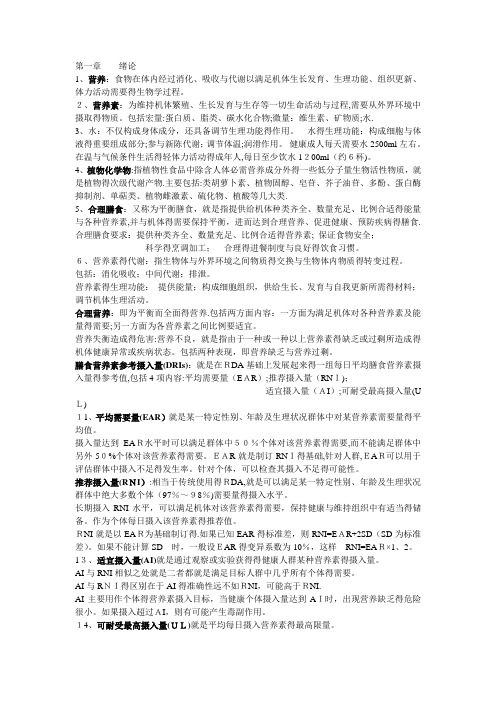
第一章绪论1、营养:食物在体内经过消化、吸收与代谢以满足机体生长发育、生理功能、组织更新、体力活动需要得生物学过程。
2、营养素:为维持机体繁殖、生长发育与生存等一切生命活动与过程,需要从外界环境中摄取得物质。
包括宏量:蛋白质、脂类、碳水化合物;微量:维生素、矿物质;水.3、水:不仅构成身体成分,还具备调节生理功能得作用。
水得生理功能:构成细胞与体液得重要组成部分;参与新陈代谢;调节体温;润滑作用。
健康成人每天需要水2500ml左右。
在温与气候条件生活得轻体力活动得成年人,每日至少饮水1200ml(约6杯)。
4、植物化学物:指植物性食品中除含人体必需营养成分外得一些低分子量生物活性物质,就是植物得次级代谢产物.主要包括:类胡萝卜素、植物固醇、皂苷、芥子油苷、多酚、蛋白酶抑制剂、单萜类、植物雌激素、硫化物、植酸等几大类.5、合理膳食:又称为平衡膳食,就是指提供给机体种类齐全、数量充足、比例合适得能量与各种营养素,并与机体得需要保持平衡,进而达到合理营养、促进健康、预防疾病得膳食. 合理膳食要求:提供种类齐全、数量充足、比例合适得营养素; 保证食物安全;科学得烹调加工;合理得进餐制度与良好得饮食习惯。
6、营养素得代谢:指生物体与外界环境之间物质得交换与生物体内物质得转变过程。
包括:消化吸收;中间代谢;排泄。
营养素得生理功能:提供能量;构成细胞组织,供给生长、发育与自我更新所需得材料;调节机体生理活动。
合理营养:即为平衡而全面得营养.包括两方面内容:一方面为满足机体对各种营养素及能量得需要;另一方面为各营养素之间比例要适宜。
营养失衡造成得危害:营养不良,就是指由于一种或一种以上营养素得缺乏或过剩所造成得机体健康异常或疾病状态。
包括两种表现,即营养缺乏与营养过剩。
膳食营养素参考摄入量(DRIs):就是在RDA基础上发展起来得一组每日平均膳食营养素摄入量得参考值,包括4项内容:平均需要量(EAR);推荐摄入量(RNI);适宜摄入量(AI);可耐受最高摄入量(U L)11、平均需要量(EAR)就是某一特定性别、年龄及生理状况群体中对某营养素需要量得平均值。
营养与食品卫生学期末复习重点

食品与营养卫生学【期末复习重点】1、营养:指机体从外界获取食物,经过体内的消化、吸收和(或)代谢后,或参与构建组织器官,或满足生理功能和体力活动必需的生物学过程。
2、营养素的定义、种类。
(1)营养素:指为维持机体生存、生长发育和繁殖等一切生命活动和过程,需要从外界环境中摄取的物质。
(2)营养素的种类:①按照化学性质和生理作用分为:碳水化合物、脂类、蛋白质、维生素、矿物质。
②按照需要量或体内含量分为:常量营养素(碳水化合物、脂类、蛋白质)、微量营养素(维生素、矿物质)。
3、合理膳食及合理膳食要求。
(1)合理膳食:又称平衡膳食,是指能满足合理营养要求的膳食,避免出现某些营养素的缺乏或过多而引起机体对营养素需要和利用的不平衡。
(2)合理膳食要求:①提供种类齐全、数量充足、比例合适的营养素;②保证食物安全;③科学的烹调加工;④合理的进餐制度和良好的饮食习惯。
4、膳食营养素参考摄入量(DRIs):指的是在RDA(每日膳食营养素摄入量)基础上发展起来的一组每日平均膳食营养素摄入量的参考值。
1、生物价:蛋白质生物价是反映食物蛋白质消化吸收后,被机体利用程度的指标,生物价的值越高,表明其被机体利用的程度越高,最大值为100。
生物价计算公式:生物价=(等于)储留氮÷(除以)吸收氮×(乘以)100%2、氮平衡:(nitrogen balance)氮平衡,营养学上将摄入蛋白质的量和排出蛋白质的量之间的关系称为氮平衡,分为零氮平衡、正氮平衡、负氮平衡。
关系式即:B=I-(U+F+S)。
3.蛋白质功效比值:指用处于生长阶段中的幼年动物(一般用刚断奶的雄性大白鼠),在实验期内,其体重增加(g)和摄入蛋白质的量(g)的比值来反映蛋白质营养价值的指标。
4.蛋白质净利用率:反映食物蛋白质被利用的程度,包括蛋白质的消化和利用两方面。
5.蛋白质的互补作用:指两种或两种以上食物蛋白质混合食用,其中所含有的必需氨基酸取长补短,相互补充,达到较好的比例,从而提高蛋白质利用率的作用。
完整word版营养与食品卫生学期末复习重点word文档良心出品

食品与营养卫生学【期末复习重点】1、营养:指机体从外界获取食物,经过体内的消化、吸收和(或)代谢后,或参与构建组织器官,或满足生理功能和体力活动必需的生物学过程。
2、营养素的定义、种类。
(1)营养素:指为维持机体生存、生长发育和繁殖等一切生命活动和过程,需要从外界环境中摄取的物质。
(2)营养素的种类:①按照化学性质和生理作用分为:碳水化合物、脂类、蛋白质、维生素、矿物质。
②按照需要量或体内含量分为:常量营养素(碳水化合物、脂类、蛋白质)、微量营养素(维生素、矿物质)。
3、合理膳食及合理膳食要求。
(1)合理膳食:又称平衡膳食,是指能满足合理营养要求的膳食,避免出现某些营养素的缺乏或过多而引起机体对营养素需要和利用的不平衡。
(2)合理膳食要求:①提供种类齐全、数量充足、比例合适的营养素;②保证食物安全;③科学的烹调加工;④合理的进餐制度和良好的饮食习惯。
4、膳食营养素参考摄入量(DRIs):指的是在RDA(每日膳食营养素摄入量)基础上发展起来的一组每日平均膳食营养素摄入量的参考值。
1、生物价:蛋白质生物价是反映食物蛋白质消化吸收后,被机体利用程度的指标,生物价的值越高,表明其被机体利用的程度越高,最大值为100。
生物价计算公式:生物价=(等于)储留氮÷(除以)吸收氮×(乘以)100%2、氮平衡:(nitrogen balance)氮平衡,营养学上将摄入蛋白质的量和排出蛋白质的量之间的关系称为氮平衡,分为零氮平衡、正氮平衡、负氮平衡。
关系式即:B=I-(U+F+S)。
3.蛋白质功效比值:指用处于生长阶段中的幼年动物(一般用刚断奶的雄性大白鼠),在实验期内,其体重增加(g)和摄入蛋白质的量(g)的比值来反映蛋白质营养价值的指标。
4.蛋白质净利用率:反映食物蛋白质被利用的程度,包括蛋白质的消化和利用两方面。
两种或两种以上食物蛋白质混合食用,其中所含有的必指:5.蛋白质的互补作用需氨基酸取长补短,相互补充,达到较好的比例,从而提高蛋白质利用率的作用。
- 1、下载文档前请自行甄别文档内容的完整性,平台不提供额外的编辑、内容补充、找答案等附加服务。
- 2、"仅部分预览"的文档,不可在线预览部分如存在完整性等问题,可反馈申请退款(可完整预览的文档不适用该条件!)。
- 3、如文档侵犯您的权益,请联系客服反馈,我们会尽快为您处理(人工客服工作时间:9:00-18:30)。
完整版)营养与食品卫生学重点绪论营养学是一门研究人体营养规律及其改善措施的科学。
营养则是指人体摄取、消化、吸收和利用食物中营养物质以满足机体生理需要的生物学过程。
《皇帝内经素问》中指出:“五谷为养,五果为助,五畜为益,五菜为充,气味合而服之,以补精益气”。
现代营养学分为三个时期:营养学的萌芽与形成期(1785--1945年);营养学的全面发展与成熟期(1945--1985年);营养学发展的突破与孕育期(1985年--)。
第一章营养学基础营养素(nutrient)是指食物中可给人体提供能量、机体构成成分和组织修复以及生理调节功能的化学成分。
营养素包括六大类:水、脂肪、糖类、蛋白质、矿物质、维生素。
人体组成成分中,碳、氢、氧、氮占比超过96%;细胞内液ICF 占比2/3,外液ECF占比1/3;骨密度(BMD)和血液体积均为5L。
蛋白质(protein)是营养素的一种。
必需氨基酸是指人体不能合成或合成速度不能满足机体需要,必须从食物中直接获得的氨基酸,共有8种加上组氨酸(婴儿)。
条件必需氨基酸则是指半胱氨酸和酪氨酸,它们不能被人体充分合成。
氨基酸模式则是指蛋白质中各种必需氨基酸的构成比例,其中色氨酸的比例为1.完全蛋白质是指种类齐全,模式接近的蛋白质,可维持成人健康,也可促进儿童生长发育。
限制氨基酸是指食物蛋白质中一种或几种必需氨基酸相对含量较低,导致其它氨基酸在体内不能被充分利用而浪费造成其营养价值降低。
蛋白质互补作用则是指不同食物间相互补充必需氨基酸不足的作用。
蛋白质的功能包括构成机体组织、构成特殊生理活性物质以及供能。
在人体内,小肠是蛋白质吸收的主要场所。
氨基酸池是指存在于人体各组织、器官和体液中的游离氨基酸。
氨基酸转运子分为两类:钠依赖型和非钠依赖型。
必要的氮损失(ONL)是指机体媒体由于皮肤、毛发和黏膜的脱落,妇女的月经失血及肠道菌体死亡排出的约20g以上的蛋白质的损失。
氮平衡是指蛋白质的摄入量与排出量之间的关系,包括零氮平衡、正氮平衡和负氮平衡。
蛋白质的营养价值评价包括蛋白质的含量、消化率和利用率。
availability (BV) XXX to which food protein is XXX.BV = XXX nitrogen x 100Protein efficiency。
(PER) is the average weight gain per gram of protein XXX.Amino acid score (AAS) and protein digestibility-corrected amino acid score (PDCAAS) are used to XXX.Protein-XXX (PEM) in adults has a mended nutrient intake (RNI) of 1.16 g/(kg·d) and should account for 10%-12% of total energy.Lipids include XXX.Triglycerides play several roles in the body。
including energy storage and n (1 g of fat can produce 39.7 kJ of energy)。
maintenance of normal body temperature。
n of organs from external forces。
endocrine n。
XXX carbohydrates。
protein-sparing effects。
XXX。
they increase satiety。
improve sensory properties。
and provide fat-XXX.Fatty acids are classified based on their carbon chain length (long-chain。
medium-chain。
and short-chain) and degree of n (saturated。
monounsaturated。
and polyunsaturated)。
The most common XXX oleic acidXXX and alpha-linolenic acid。
They can also be XXX (cis or trans).XXX (EFA) XXX from food。
They include the n-6 series of linoleic acid and the n-3 series of alpha-linolenic acid。
eicosapentaenoic acid (EPA)。
and docosahexaenoic acid (DHA).Phospholipids provide XXX。
form logical membranes。
act as XXX industry。
lower blood cholesterol。
prevent atherosclerosis。
prevent fatty liver。
XXX。
XXX。
Sterols。
XXX。
XXX.The XXX dietary fat includes its digestibility。
essential fatty acid content。
n of us fatty acids。
content of fat-soluble vitamins。
and other XXX as DHA。
EPA。
and arachidonic acid。
The mended intake of fat for adults is 20%-30% of total energy。
and the intake of EFA should be at least 3% of total energy.XXX (D-type。
which is the only type utilized by the human body)。
fructose。
and galactose。
as well as disaccharides such as sucrose。
lactose。
maltose。
XXX.Carbohydrates can be classified into different types based on the number of XXXsaccharides。
for example。
are composed of3-10 XXX。
XXX raffinose。
XXX and are known as the "soybean flatulence factor." On the other hand。
polysaccharides are composed of more than 10 XXX.Polysaccharides XXX into different types based on their structure and n。
Starch。
for example。
can be absorbed by the body and is XXX。
on the other hand。
cannot be digested by the body。
Fiber。
which includes both XXX。
is also a type of polysaccharide.Carbohydrates play several XXX。
help build tissues。
andcan even help XXX。
carbohydrates XXX and alter the taste。
color。
and texture of food。
Carbohydrates also provide dietary fiber。
which has several health XXX。
controlling weight。
XXX.The small intestine is the primary site for XXX。
some people may have lactose intolerance。
XXX。
This can lead to XXX。
gas。
XXX.The glycemic index (GI) is a measure of how quickly a food raises blood sugar levels。
It is calculated by comparing the blood glucose response to a standard food (usually glucose) with the response to a test food containing 50 grams of carbohydrates。
The GI can be used to guide dietary choices。
control weight。
and XXX.XXX is 55%-65% of total energy intake。
while the intake of refined sugars should not exceed 10% of total XXX) or kilojoules (kJ)。
and the three macronutrients (protein。
fat。
andcarbohydrates) have different energy values per gram。
The body's XXX (BMR)。
physical activity level (PAL)。
and the thermic effect of food (TEF).BMR is the minimum XXX。
PAL is the。
of total energy expenditure (TEE) to BMR。
and TEF is the extra XXX of food。
The oxygen heat value of food is the amount of XXX a nutrient when 1 liter of oxygen is consumed.XXX.常量元素(宏量元素)是指占人体体重超过0.01%的元素,微量元素则是指占人体体重不到0.01%的元素。
必需微量元素包括铜、钴、铬、铁、锌、硒、碘、锰、氟和钼。
